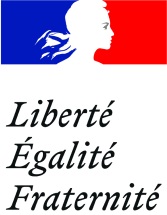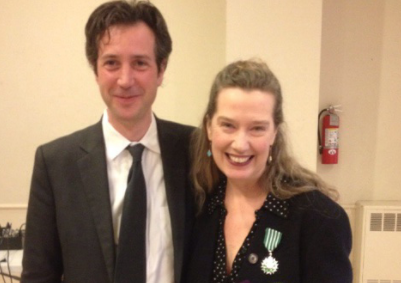On Saturday, May 17, Judy Hussie-Taylor, Executive Director of Danspace Project, was honored with the insignia of the Ordre des Arts et des Lettres by Antonin Baudry, Cultural Counselor of the French Embassy.
A home to Danspace Project and other experimental arts groups for decades, the landmark St. Mark’s Church was the timeless setting for the ceremony, which coincided with a three-day period of performance and conversation at Danspace Project, organized in conjunction with the French Embassy. Mr. Baudry highlighted Ms. Hussie-Taylor’s intellectual and cross-disciplinary approach, resulting in original initiatives such as “Platforms” which brings artists, curators, critics, and audience members together. Rightly called a “Mover and Shaper” by the New York Times, Ms. Hussie-Taylor has changed the course of contemporary dance and strengthened the transatlantic link between French and American artists.
____________________________________________________
Dear Friends,
Tonight I am honored to greet you at one of the most innovative artistic centers in New York. With the community of a church and the audacity of an art gallery, Danspace reflects the inclusive spirit of New York City.
Under the leadership of Judy Hussie-Taylor, Danspace has become an unparalleled force. And Judy’s intellectual and cross-disciplinary approach have rejuvenated contemporary dance in New York.
I extend a warm welcome to Judy’s friends and family members, her colleagues, and especially her husband, Steve Taylor and son Eamonn, who have each come to show their support and admiration as she enters into the French Order of Arts and Letters.
Reflecting on Danspace and on Judy’s amazing career, I am reminded of the power of dance to anchor us in a moment. Focusing deeply on our present makes me think of existentialism. Albert Camus writes in The Stranger: “If something is going to happen to me, I want to be there.” Like existentialism, contemporary dance shifts our perspective away from the superficial and toward real human experiences.
These words connect seamlessly with Judy’s tremendous work at Danspace. Her artist’s eye has added great creative dimension to the institution and to the New York dance scene.
The history of Danspace is as nuanced as its neighborhood. Its soul grew out of two intermingled philosophies. As you know, in the early 60s, the Rector of St. Marks established two central principles. Maybe he was influenced by the psychedelic times, but the first one was to “let people be.”
The second was to “foster models of self-determination,” meaning to allow artists to collaborate, experiment, and even fail. Judy has expanded on this philosophy through her original initiatives, like the “Choreographic Center Without Walls”, “Platforms” and by assuring collaborators “the answer is yes until it has to be no.”
As the daughter of a journalist father and the sister of many visual artists, Judy grew up around all types of art. Redon, Renoir, Bonnard, Matisse, and Monet were household names, discussed frequently at dinner.
At thirteen, her big sister told Judy that she must get out of the house and start taking piano classes. As Judy was the youngest of nine siblings, maybe this was more of a survival tip. Nevertheless, taking her older sister’s advice, Judy signed up for dance classes — the start of a lifelong passion.
After studying creative writing, Judy’s art-driven career took her to the Colorado Dance Festival. Later she headed to the Boulder Museum of Contemporary Art, where she developed an interdisciplinary performance program. At the Museum of Contemporary Art in Denver, Judy served as deputy director and continued to experiment with new ideas.
As we can see, Judy’s past reveals a love for diverse art forms, and her present combines them. For Judy, contemporary dance is not isolated, it is a node in an interconnected web of creativity.
Taking the helm of Danspace in 2008, Judy amazed her admirers with a drastically new vision of dance programming. Through the Choreographic Center Without Walls, she supports the work of American and international artists. Just a few examples are Emmanuelle Huynh, Dd Dorvillier, and Francophone artist Bouchra Ouizguen. These artists have enabled Judy and Danspace to take a stance, empower women through the arts and follow in the footsteps of feminist masters Simone de Beauvoir, Janette Laverriere, Louise Bourgeois and Françoise Gillot.
In her Platforms program at Danspace, Judy stays true to her cross-disciplinary approach by combining text and performance. She frames performing arts presentations as “exhibitions that unfold over time” and generates original catalogues that illuminate the artists’ processes. Platforms has even inspired our own series of publications for the Embassy’s DANSE festival, closing tomorrow.
Judy once said that dancers can “activate a space,” but I would say that Judy activates the entire New York community. By approaching dance with a growth-geared outlook, Judy ensures a rich future for contemporary dance. She is an indispensable force in the New York dance scene, and her original initiatives have ensured that Danspace will remain a staple of our culture for years to come.
Judy’s approach has been called a “radical way of packaging art,” and praised as “artist-centric.” Her programs are founded on relationships, and brings artists, curators, scholars, critics, and audience members together in dynamic discourse. For Judy, arts curation is an act of inquiry and opens up possibilities.
Judy is dedicated to nurturing the careers of artists and focuses more on furthering a dancer’s research than on offering a spectacle. In doing so, she presents shows with depth and candor.
As well as an artist, Judy is a mentor and shares her talents with students. Since 2010, she has been a founding faculty member and advisor at the Institute for Curatorial Practice in Performance at Wesleyan University, the first academic performing arts curation program in the U.S. The Institute was founded by Judy’s friend, Sam Miller, President of the Lower Manhattan Cultural Council, who is here with us tonight.
Judy’s creative vision has changed the course of contemporary dance. She has strengthened the transatlantic link between France and America and established countless collaborations among French and American dancers including Cecilia Bengolea and Francois Chaignaud.
We honor Judy — who is rightly hailed as a “Mover and Shaper” by the New York Times — because she has added intellectual, artistic, and human dimension to dance in New York City.
After all, Pina Bausch was right—dance isn’t about pliés but about its power to bring us together. And I can’t think of anyone who does this better than Judy.
Judy Hussie-Taylor, au nom du gouvernement français, je vous fais Chevalier dans l’Ordre des Arts et des Lettres.
SHARE



